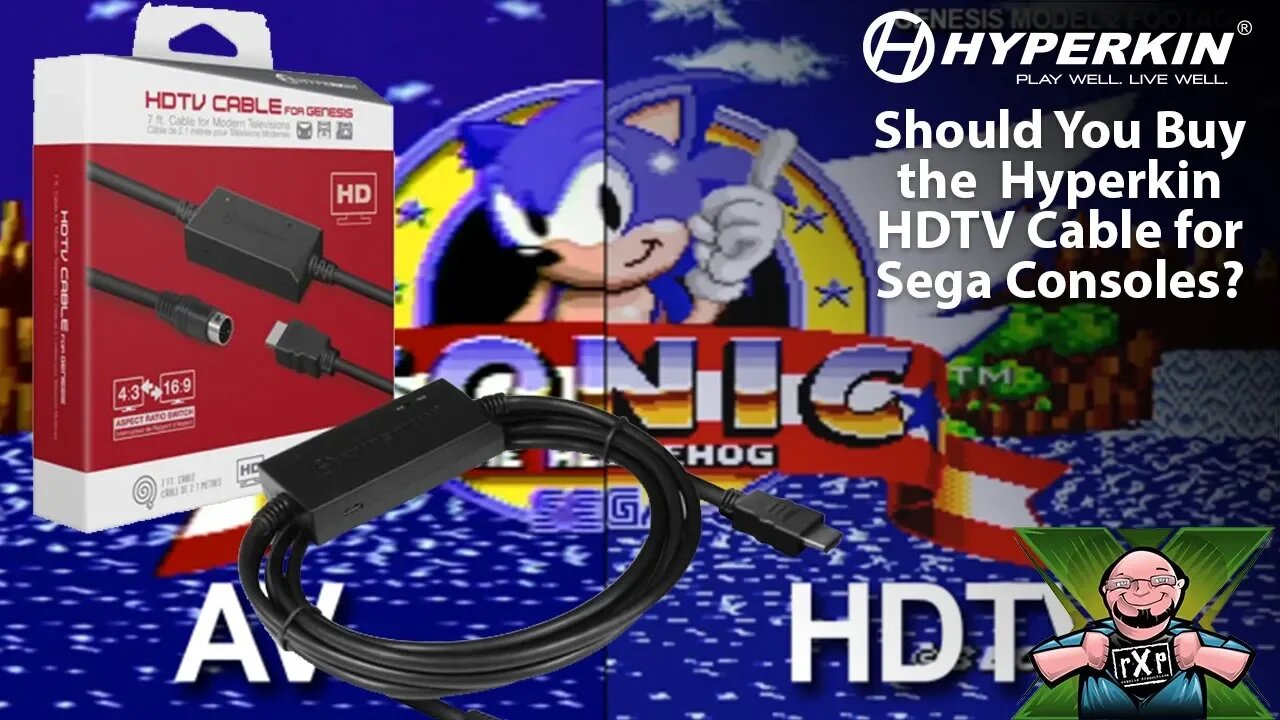Premium Only Content

Should You Buy the Hyperkin HDTV Cable for the Sega Genesis Mega Drive and Master System
In this video, we unbox and test out the Hyperkin HD TV cable design to work with Sega consoles, including the Genesis, Mega Drive, and Master System.
Recently, Hyperkin has released a series of HDMI cables for retro consoles, their latest design for the Sega Genesis and Mega Drive. Or at least that's what the box states, we'll get into more of that in a bit. What this promises is a plug-and-play solution that allows you to connect your Model 1, Model 2, or Model 3 Genesis to your television via HDMI with some upscaling to 720P. In addition, because it is compatible with the Model 1 Genesis you can also use it with the Sega Master System
The 7’ long cable itself comes with a Model 1 to Model 2 Genesis adapter, that's what allows it to connect to a Master System as well! A micro USB cable is also included if you need to connect to an exterior power source, and the cable itself. The middle of the cable features a decent-sized box, which is where all of the magic happens. The outside of the box features a 4x3 or 16x9 switch, so you can select whatever aspect ratio you prefer. If your television does not provide enough current to power the cable and the integrated box, there is a micro USB port for you to attach included cable to for power.
Seeing that it will work with a Master System that's exactly what I tested it out with first. Now with my capture set up, I did have to apply external power to the box itself which, ironically, I was able to do using my using EZcap 284 capture card. I could definitely tell that the picture looks better than using composite video cables, but it still looks a little blurry when compared to RGB cables. Initial impressions is that this cable takes the Composite video signal and upscales it to 720P while converting the connector to HDMI.
Moving on to my Genesis, there were some very similar performance traits. I noticed overscan on either side of the picture, pretty common with the Genesis a flat panel TV. I also noticed that the sprites were still blurry looking, just like on the Master System. The Sega CD and 32x looked a little bit better, but it still had that blurriness to it.
You may be asking why would it look blurry even though it's being upscale to 720p? These cables are very similar to AVtoHDMI converter boxes, but instead of having separate inputs and outputs, it's all built into one. You may have some kind of a filter built into the cable itself to eliminate some of the “jaggies” which can affect some upscaled retro gaming images.
Why it RoX?
- Reasonable price
- Plug-and-play compatible with the Sega Genesis Models 1 through 3, and the Sega Master System
- 4x3 and 16x9 switch
- No lag that I could perceive
What could be improved?
- The length of the cable is a little short for my taste
- The applied filter makes the images somewhat blurry and the pixels less Sharp
- Colors did not look as vibrant as RGB cables
Should you buy one?
If you know what a Framemeister, and OSSC, or RGB cables are, this is not the product for you. This is designed for an entry-level consumer looking to connect their retro Sega consoles to a modern flat panel TV. It has been designed for convenience and ease-of-use, and it does sacrifice some video quality to accomplish that. I didn't hate what it was doing to my video, but I wasn't necessarily in love with it. Do not look at this as a replacement for a traditional upscaler or line doubler, look at this as a replacement cable that eliminates an AVtoHDMI adapter box in one convenient package. If you are considering one of those adapter boxes, this is a superior solution.
The footage used in this review are used under the Fair Use laws, referenced below:
https://www.law.cornell.edu/uscode/text/17/107
Notwithstanding the provisions of sections 106 and 106A, the fair use of a copyrighted work, including such use by reproduction in copies or phonorecords or by any other means specified by that section, for purposes such as criticism, comment, news reporting, teaching (including multiple copies for classroom use), scholarship, or research, is not an infringement of copyright. In determining whether the use made of a work in any particular case is a fair use the factors to be considered shall include—
(1) the purpose and character of the use, including whether such use is of a commercial nature or is for nonprofit educational purposes;
(2) the nature of the copyrighted work;
(3) the amount and substantiality of the portion used in relation to the copyrighted work as a whole; and
(4) the effect of the use upon the potential market for or value of the copyrighted work.
The fact that a work is unpublished shall not itself bar a finding of fair use if such finding is made upon consideration of all the above factors.
(Pub. L. 94–553, title I, § 101, Oct. 19, 1976, 90 Stat. 2546; Pub. L. 101–650, title VI, § 607, Dec. 1, 1990, 104 Stat. 5132; Pub. L. 102–492, Oct. 24, 1992, 106 Stat. 3145.)
-
 19:59
19:59
RoXolidProductions
9 months ago $0.04 earnedPlay Japanese Super Famicom Games On US Super Nintendo!! NEStoration™ Region Free Mod Kit
3142 -
 LIVE
LIVE
Akademiks
2 hours agoJay Z says he aint NEVER been friends w/ DIDDY! Bhad Bhabie lost her man? Travis Hunter Down Bad?
2,637 watching -
 LIVE
LIVE
AirCondaTv Gaming
1 hour agoWar Thunder - Tankering Around for That 10 Bomb
26 watching -
 LIVE
LIVE
SpartakusLIVE
3 hours agoThe MACHINE locks in for 12-hour POWER stream
174 watching -
 LIVE
LIVE
Robert Gouveia
2 hours agoJ6 Coverup: Prosecute LIZ CHENEY; NY Judge REJECTS Immunity; Trump Breaks Gag?
3,695 watching -
 LIVE
LIVE
WeAreChange
1 hour agoPSYOP Spreads: Drones Shut Down Airport In New York!
2,142 watching -
 1:31:18
1:31:18
Redacted News
3 hours agoEMERGENCY! NATO AND CIA ASSASSINATE TOP RUSSIAN GENERAL, PUTIN VOWS IMMEDIATE RETALIATION | Redacted
131K132 -
 56:45
56:45
VSiNLive
2 hours ago $3.40 earnedFollow the Money with Mitch Moss & Pauly Howard | Hour 1
29.3K2 -
 52:44
52:44
Candace Show Podcast
3 hours agoMy Conversation with Only Fans Model Lilly Phillips | Candace Ep 122
35.4K184 -
 UPCOMING
UPCOMING
tacetmort3m
3 hours ago🔴 LIVE - RELIC HUNTING CONTINUES - INDIANA JONES AND THE GREAT CIRCLE - PART 5
6.89K